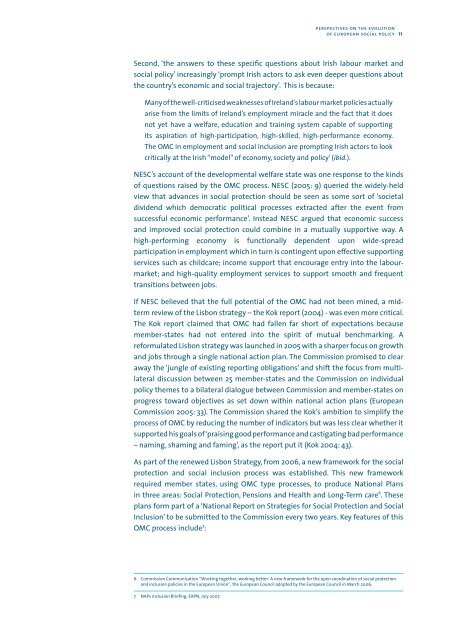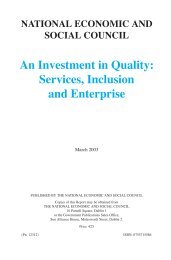4. Perspectives on the Evolution of European Social Policy
4. Perspectives on the Evolution of European Social Policy
4. Perspectives on the Evolution of European Social Policy
- No tags were found...
Create successful ePaper yourself
Turn your PDF publications into a flip-book with our unique Google optimized e-Paper software.
perspectives <strong>on</strong> <strong>the</strong> evoluti<strong>on</strong><strong>of</strong> european social policy 11Sec<strong>on</strong>d, ‘<strong>the</strong> answers to <strong>the</strong>se specific questi<strong>on</strong>s about Irish labour market andsocial policy’ increasingly ‘prompt Irish actors to ask even deeper questi<strong>on</strong>s about<strong>the</strong> country’s ec<strong>on</strong>omic and social trajectory’. This is because:Many <strong>of</strong> <strong>the</strong> well-criticised weaknesses <strong>of</strong> Ireland’s labour market policies actuallyarise from <strong>the</strong> limits <strong>of</strong> Ireland’s employment miracle and <strong>the</strong> fact that it doesnot yet have a welfare, educati<strong>on</strong> and training system capable <strong>of</strong> supportingits aspirati<strong>on</strong> <strong>of</strong> high-participati<strong>on</strong>, high-skilled, high-performance ec<strong>on</strong>omy.The OMC in employment and social inclusi<strong>on</strong> are prompting Irish actors to lookcritically at <strong>the</strong> Irish “model” <strong>of</strong> ec<strong>on</strong>omy, society and policy’ (ibid.).NESC’s account <strong>of</strong> <strong>the</strong> developmental welfare state was <strong>on</strong>e resp<strong>on</strong>se to <strong>the</strong> kinds<strong>of</strong> questi<strong>on</strong>s raised by <strong>the</strong> OMC process. NESC (2005: 9) queried <strong>the</strong> widely-heldview that advances in social protecti<strong>on</strong> should be seen as some sort <strong>of</strong> ‘societaldividend which democratic political processes extracted after <strong>the</strong> event fromsuccessful ec<strong>on</strong>omic performance’. Instead NESC argued that ec<strong>on</strong>omic successand improved social protecti<strong>on</strong> could combine in a mutually supportive way. Ahigh-performing ec<strong>on</strong>omy is functi<strong>on</strong>ally dependent up<strong>on</strong> wide-spreadparticipati<strong>on</strong> in employment which in turn is c<strong>on</strong>tingent up<strong>on</strong> effective supportingservices such as childcare; income support that encourage entry into <strong>the</strong> labourmarket;and high-quality employment services to support smooth and frequenttransiti<strong>on</strong>s between jobs.If NESC believed that <strong>the</strong> full potential <strong>of</strong> <strong>the</strong> OMC had not been mined, a midtermreview <strong>of</strong> <strong>the</strong> Lisb<strong>on</strong> strategy – <strong>the</strong> Kok report (2004) - was even more critical.The Kok report claimed that OMC had fallen far short <strong>of</strong> expectati<strong>on</strong>s becausemember-states had not entered into <strong>the</strong> spirit <strong>of</strong> mutual benchmarking. Areformulated Lisb<strong>on</strong> strategy was launched in 2005 with a sharper focus <strong>on</strong> growthand jobs through a single nati<strong>on</strong>al acti<strong>on</strong> plan. The Commissi<strong>on</strong> promised to clearaway <strong>the</strong> ‘jungle <strong>of</strong> existing reporting obligati<strong>on</strong>s’ and shift <strong>the</strong> focus from multilateraldiscussi<strong>on</strong> between 25 member-states and <strong>the</strong> Commissi<strong>on</strong> <strong>on</strong> individualpolicy <strong>the</strong>mes to a bilateral dialogue between Commissi<strong>on</strong> and member-states <strong>on</strong>progress toward objectives as set down within nati<strong>on</strong>al acti<strong>on</strong> plans (<strong>European</strong>Commissi<strong>on</strong> 2005: 33). The Commissi<strong>on</strong> shared <strong>the</strong> Kok’s ambiti<strong>on</strong> to simplify <strong>the</strong>process <strong>of</strong> OMC by reducing <strong>the</strong> number <strong>of</strong> indicators but was less clear whe<strong>the</strong>r itsupported his goals <strong>of</strong> ‘praising good performance and castigating bad performance– naming, shaming and faming’, as <strong>the</strong> report put it (Kok 2004: 43).As part <strong>of</strong> <strong>the</strong> renewed Lisb<strong>on</strong> Strategy, from 2006, a new framework for <strong>the</strong> socialprotecti<strong>on</strong> and social inclusi<strong>on</strong> process was established. This new frameworkrequired member states, using OMC type processes, to produce Nati<strong>on</strong>al Plansin three areas: <strong>Social</strong> Protecti<strong>on</strong>, Pensi<strong>on</strong>s and Health and L<strong>on</strong>g-Term care . Theseplans form part <strong>of</strong> a ‘Nati<strong>on</strong>al Report <strong>on</strong> Strategies for <strong>Social</strong> Protecti<strong>on</strong> and <strong>Social</strong>Inclusi<strong>on</strong>’ to be submitted to <strong>the</strong> Commissi<strong>on</strong> every two years. Key features <strong>of</strong> thisOMC process include :Commissi<strong>on</strong> Communicati<strong>on</strong> “Working toge<strong>the</strong>r, working better: A new framework for <strong>the</strong> open coordinati<strong>on</strong> <strong>of</strong> social protecti<strong>on</strong>and inclusi<strong>on</strong> policies in <strong>the</strong> <strong>European</strong> Uni<strong>on</strong>”, <strong>the</strong> <strong>European</strong> Council adopted by <strong>the</strong> <strong>European</strong> Council in March 2006. NAPs inclusi<strong>on</strong> Briefing, EAPN, July 2007.
















